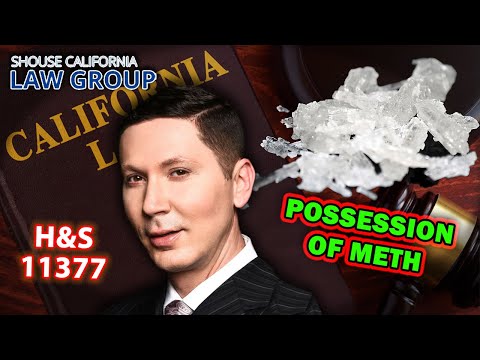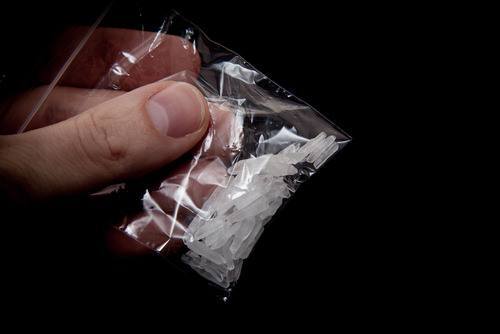
California Health and Safety Codes 11377-11379.6 HS make it a crime to possess, sell, transport, or manufacture controlled substances such as methamphetamine. Simple possession is typically a misdemeanor charge that can get dismissed without jail if you complete drug diversion. Most other meth charges are felonies, though judges may grant probation instead of incarceration.
| California methamphetamine crime | Maximum jail/prison term (generally) |
| Simple possession – 11377 HS |
|
| Possession for sale – 11378 HS |
|
| Selling/transporting (“trafficking”) – 11379 HS |
|
| Manufacturing – 11379.6 HS |
|
| Being under the influence – 11550 HS |
|
| Driving under the influence – 23152f VC |
|
In this article, our California criminal defense attorneys summarize the state methamphetamine laws including possible penalties and legal defenses:
- 1. Possessing methamphetamine (11377 HS)
- 2. Possessing methamphetamine for sale (11378 HS)
- 3. Transporting or selling (“trafficking”) methamphetamine (11379 HS)
- 4. Manufacturing methamphetamine (11379.6 HS)
- 5. Being under the influence of methamphetamine (11550 HS)
- 6. Driving under the influence of methamphetamine (23152f VC)
- 7. How to fight criminal charges
- Additional resources
1. Possessing methamphetamine (11377 HS)
Health and Safety Code 11337 HS prohibits “simple possession” in California, which is possessing controlled substances for personal use. If you are charged with simple possession of methamphetamine, the prosecutor needs to prove that you had either:
- actual possession, meaning that you were carrying the meth on your person;
- constructive possession, meaning that the meth was under your control (such as being stored in your drawer at home); and/or
- joint possession, meaning you shared control of the meth with at least one other person such as a roommate, friend, or spouse.
Simple meth possession is usually prosecuted as a misdemeanor in California with a maximum sentence of 1 year in jail and/or $1,000 in fines. Though if you are eligible, judges will dismiss your case if you finish a drug diversion program, such as:
Note that simple meth possession can be treated as a felony if you have prior convictions for certain serious crimes, such as registrable sex offenses. The punishment in California can be up to $10,000 in fines and a jail sentence of:
- 16 months,
- 2 years, or
- 3 years.
Though even then, judges usually have the discretion to grant probation instead.1

A schedule II drug, methamphetamine also goes by the names ice, crank, glass, and speed.
2. Possessing methamphetamine for sale (11378 HS)
Health and Safety Code 11378 HS makes it a California crime to possess drugs with the intention of selling them.2 A prosecutor must prove four things in order to convict you of possessing methamphetamine for sale:
- you knowingly possessed meth,
- you knew that it was a controlled substance,
- you possessed enough of it to sell it for consumption, and
- you had the specific intent to sell it.
If you are found with large amounts of meth – more than one person would typically consume recreationally – the police will usually presume you intended to sell the drugs. Other signs police look for to indicate “intent to sell” are:
- you have large amounts of cash
- you are carrying a gun
- you were spotted in an area where drug deals often happen
Possession of methamphetamine for sale is charged as a California felony carrying 16 months, two years, or three years in jail plus up to $10,000.3
3. Transporting or selling (“trafficking”) methamphetamine (11379 HS)
Health and Safety Code 11379 HS makes trafficking controlled substances a California crime. Trafficking methamphetamine comprises:
- transporting meth,
- selling meth,
- furnishing meth,
- administering meth,
- importing meth into California,
- giving away meth, or
- offering to do any of the above.
Upon a conviction for selling, transporting, or otherwise trafficking methamphetamine in California, the judge can impose a sentence of two, three, or four years in jail plus up to $10,000. Though if the meth was transported across more than two county lines with the intent to sell the drugs at the destination, the sentence is enhanced to three, six, or nine years.4
When judges decide which sentencing term to impose, they will probably hand down the longest one if you knew – or reasonably should have known – that the recipient of the methamphetamine:
- was pregnant,
- had a violent felony conviction, or
- was in treatment for a mental health disorder or for a drug problem.5
4. Manufacturing methamphetamine (11379.6 HS)
Health and Safety Code 11379.6 HS is the California crime that prohibits manufacturing controlled substances such as methamphetamine. This comprises:
- operating a meth lab, or
- mixing “precursor” chemicals that can be meth ingredients.
Manufacturing meth is a felony in California. The crime is punishable by:
- 3, 5 or 7 years in jail, and
- up $50,000.6
5. Being under the influence of methamphetamine (11550 HS)
Health and Safety Code 11550 HS punishes you merely for being under the influence of controlled substances in California, even if there are no longer any drugs in your possession.7 For you to get convicted of being under the influence of methamphetamine, the D.A. has the burden to prove that:
- your physical or mental abilities are impaired “in any detectable manner,” and
- meth caused your impairment.8
As a California misdemeanor, being under the influence of methamphetamine carries up to one year in jail and/or $1,000. Though if you complete a diversion program, you may be able to do probation instead of jail and avoid a conviction.9
6. Driving under the influence of methamphetamine (23152f VC)
Vehicle Code 23152(f) VC forbids driving in California while under the influence of controlled substances.10 For you to be convicted of driving while impaired by methamphetamine, the D.A. has to prove that the drug:
“so far affected the nervous system, the brain, or muscles as to impair to an appreciable degree the ability to operate a vehicle in a manner like that of an ordinarily prudent and cautious person in full possession of his faculties.”11
A misdemeanor (in most cases), driving under the influence of drugs (DUID) is treated identically to driving under the influence of alcohol (DUI). The sentence for a first-time conviction includes up to six months in jail, up to $1,000 in fines, a driver’s license suspension, and DUI school.12

Methamphetamine law violations are deportable under 8 U.S.C. 1227.
7. How to fight criminal charges
Here at Shouse Law Group, we have represented literally thousands of people charged with methamphetamine crimes. In our experience, the following seven defenses have proven very effective with prosecutors, judges, and juries in California:
1) The search was unlawful
If we can show the court that the police did not have probable cause to search you, then any evidence they discovered through the search can be suppressed (which means that it cannot be used during trial). The D.A. may then be left with too little evidence to convict you for violating methamphetamine laws.
2) Law enforcement entrapped you
It is legal for police to go undercover and to ask you to buy or sell them drugs. Though if the police in your case unduly pressured you, then they unlawfully entrapped you, and we may be able to persuade the D.A. to drop the case.
3) There was no legal possession
For you to meet the definition of possessing meth, you have to know it is there. Therefore if someone planted the meth on you or left it in your place without telling you, you were not in possession and violated no methamphetamine laws.
4) There was no drug impairment
Being under the influence of meth resembles non-drug related medical conditions, such as a manic episode or having too much insulin. There may be eyewitness accounts, video surveillance footage, or your own medical records that will be able to show prosecutors your criminal charge is baseless and not worth pursuing.
5) You did not plan to sell the methamphetamine
The D.A. may reduce your possession for sale charge down to simple possession if we show them they lack enough evidence to prove you planned to sell the drugs. For instance, just because you carried cash and a gun does not necessarily mean you were planning a drug deal. Unless prosecutors can convince a jury beyond a reasonable doubt that you broke a methamphetamine law, no criminal charges can stand.
6) There was no methamphetamine
We can call upon forensic experts to investigate what exactly the police found and whether it was indeed illegal. If only trace amounts of meth were in your possession – or if the drugs ended up being imitation and not actual controlled substances – then the court should dismiss your case.13
7) Police coerced your confession
Police may not violate the Fourth Amendment when interrogating you. If they used overbearing methods to extract a confession from you, we may be able to get that suppressed as evidence and the case ultimately dismissed.
Additional resources
For help or more information beyond California methamphetamine laws, refer to the following:
- Narcotics Anonymous (NA) – A 12-step program to overcome drug addiction.
- Substance Abuse and Mental Health Service Administration (SAMHSA) – 24/7 treatment referral service.
- Crystal Meth: What You Should Know – WebMD article about the drug’s properties and treatment.
- Methamphetamine – Drug Enforcement Administration fact-sheet on methamphetamine.
- Ice – Alcohol and Drug Foundation overview of methamphetamine.
Legal References
- California Health and Safety Code 11377 HS. See also California Penal Code 1210.1 PC. California Penal Code 1000 PC.
- California Health and Safety Code 11378 HS. See also People v. Buttram, (2003) 30 Cal. 4th 773.
- Same.
- California Health and Safety Code 11379 HS.
- California Penal Code 1170.82 PC.
- California Health and Safety Code 11379.6 HS.
- California Health and Safety Code 11550 HS.
- People v. Enriquez (1996) 42 Cal.App.4th 661.
- See note 7.
- California Vehicle Code 23152f VC.
- See note 8.
- See note 10.
- People v. Tripp (Court of Appeal of California, Fifth Appellate District, 2007) 151 Cal. App. 4th 951.
